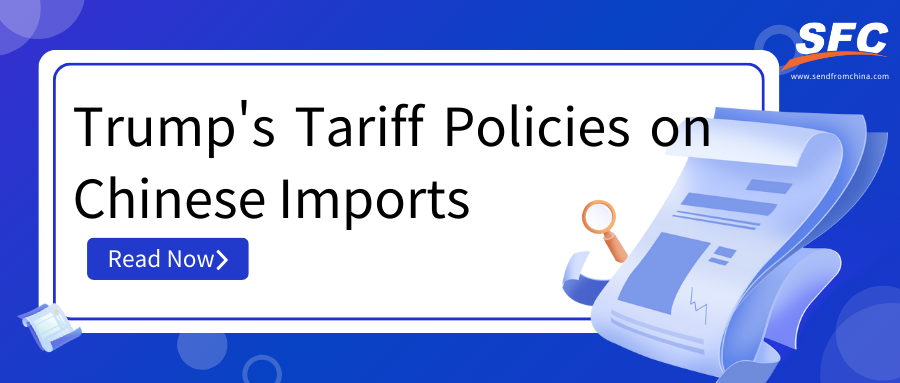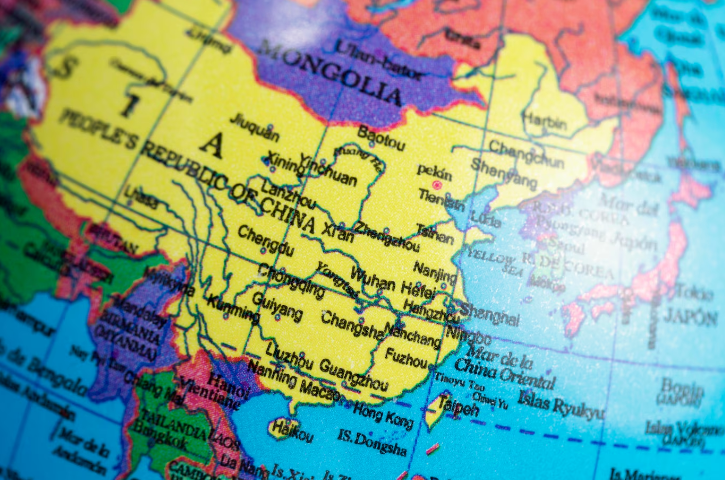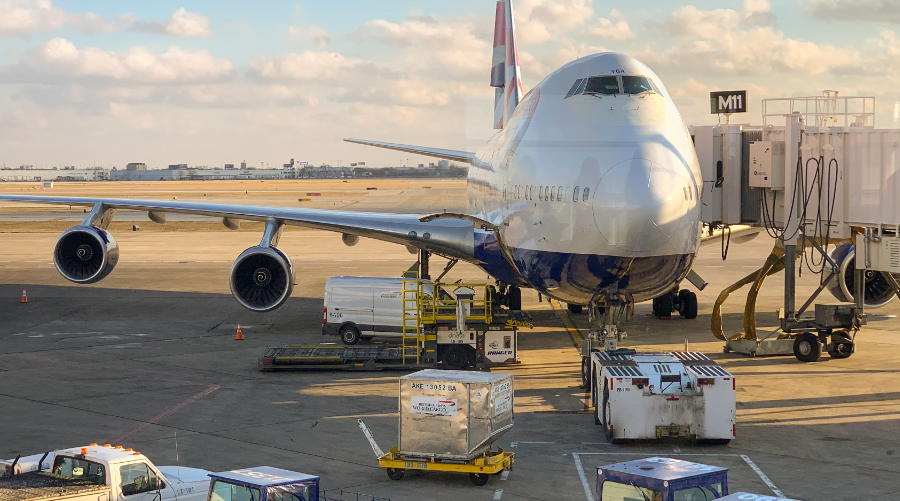Table of Contents
Trump's Tariff Policies on Chinese Imports: A Comprehensive Overview
Time: Feb 10,2025 Author: SFC Source: www.sendfromchina.com
In recent years, the United States has witnessed significant shifts in its trade policies, particularly concerning imports from China. Under President Donald Trump's administration, there has been a marked emphasis on rebalancing trade dynamics, addressing perceived unfair practices, and bolstering domestic industries.Our blog article delves into the evolution of these policies, examining their origins, implementations, and the broader implications for global trade.

1. First Term Actions (2017-2021): Initiation of the Trade War
During President Trump's first term, the administration took decisive steps to address trade concerns with China, marking the beginning of what became widely known as the U.S.-China trade war.March 2018: Steel and Aluminum Tariffs
In March 2018, President Trump signed orders imposing tariffs of 25% on imported steel and 10% on aluminum. While these measures targeted multiple countries, China, as a major exporter of these metals, was significantly impacted. The administration cited national security concerns and the need to protect domestic industries as primary justifications for these tariffs.July 2018: Escalation with $34 Billion Tariffs
By July 2018, tensions escalated as the U.S. implemented a 25% tariff on $34 billion worth of Chinese goods. This move targeted a range of products, from machinery to electronics, aiming to pressure China into addressing issues related to intellectual property theft and forced technology transfers. In retaliation, China imposed equivalent tariffs on U.S. goods, signaling a deepening trade conflict.2. Second Term Strategies (2025-Present): Renewed Trade Tensions

January 2025: Declaring Economic Emergency
In January 2025, the administration considered declaring a "national economic emergency," invoking the International Emergency Economic Powers Act (IEEPA) and sections of the U.S. Trade Act. This move was intended to provide a legal framework for imposing additional tariffs on Chinese goods, emphasizing the urgency of addressing trade imbalances and protecting national interests.February 2025: Comprehensive Tariff Implementation
By February 2025, President Trump signed an executive order imposing a 10% tariff on all Chinese imports. The broad measure covered a vast array of products, signaling a comprehensive approach to recalibrating trade relations. The administration emphasized that these actions were crucial for safeguarding American industries and reducing dependence on foreign supply chains.Tariffs are a key component of Trump’s economic strategy, which aims to boost the US economy, safeguard jobs, and increase tax revenue. Since his inauguration, there has been a series of tariff-related announcements.
Earlier this month, Trump threatened to impose 25% import duties on products from Canada and Mexico. However, he postponed the implementation for 30 days, extending it to early March, after discussions with both nations' leaders.
In addition, Trump introduced new US tariffs of 10% on all Chinese imports.
In response, Beijing retaliated with its own tariffs, effective Monday, targeting US coal, oil, gas, agricultural machinery, large-engine vehicles, and imposing export restrictions on 25 rare metals critical for electric and military equipment.
Trump also announced plans to introduce reciprocal tariffs on all countries that tax US imports, matching their respective tariff rates. He assured that this approach would be beneficial for the US and other nations, stating, "It'll be great for everybody, including other countries."
On February 27, 2025, Eastern Time, U.S. President Donald Trump announced an additional 10% tariff on Chinese exports to the United States, which will take effect on March 4. This is a further measure on top of the 10% tariff already imposed on February 1, potentially bringing the total tariff on Chinese goods to 20%. Additionally, tariff measures on Canada and Mexico will also take effect on the same day. Trump's tariff policy has a significant impact on cross-border e-commerce. Businesses need to respond to the challenges by diversifying their supply chains, optimizing cost structures, and enhancing brand value. Additionally, flexibly adjusting market strategies and strengthening policy risk management will be crucial.
The spokesperson for China’s Ministry of Commerce responded to the U.S. threat of imposing an additional 10% tariff on Chinese exports to the United States:
"China has taken note of the situation. China has repeatedly stated that unilateral tariffs violate World Trade Organization (WTO) rules and undermine the multilateral trade system. China firmly opposes such actions.
China is one of the countries with the strictest and most rigorously enforced anti-drug policies in the world and actively engages in international anti-drug cooperation with countries including the United States. However, the U.S. has consistently ignored objective facts, previously imposing a 10% tariff on China under the pretext of fentanyl-related issues, and is now once again threatening additional tariffs. Such actions are nothing more than an attempt to shift blame, which does nothing to resolve the U.S.’s own problems.Instead, they will further increase the burden on American businesses and consumers while destabilizing the global supply chain.
China urges the U.S. not to repeat its mistakes and to return as soon as possible to the correct path of resolving differences through equal dialogue. If the U.S. insists on acting unilaterally, China will take all necessary countermeasures to safeguard its legitimate rights and interests."
3. Sector-Specific Impacts: Targeted Industries and Economic Repercussions

High-Tech Industries
High-tech sectors, particularly those involving electronics and machinery, faced increased production costs due to tariffs on imported components from China. Companies had to navigate disrupted supply chains and consider alternative sourcing strategies to mitigate the impact of increased costs.Consumer Goods and Electronics
Consumers experienced price hikes in various goods, including electronics, apparel, and household items, as importers passed on the additional costs resulting from tariffs. Retailers and manufacturers grappled with balancing cost absorption and price adjustments to maintain competitiveness.4. Economic Implications: Assessing the Impact on Global Supply Chains

Companies heavily reliant on Chinese manufacturing are compelled to reassess their sourcing strategies. For instance, Newell Brands, the maker of Sharpie, announced plans to reduce its dependence on Chinese suppliers to mitigate the effects of U.S. import tariffs. The company aims to decrease the cost of goods imported from China to less than 10% by the end of the year.
The closure of the de minimis trade loophole, which previously allowed packages worth less than $800 to enter the U.S. duty-free, has particularly impacted e-commerce giants like Shein and Temu. It is expected to lead to increased shipping times and shipping costs, as packages now require thorough customs inspections. Experts predict that shipping times could double, and prices for consumers may rise as companies adjust to the new regulations.
These developments underscore the broader economic implications of the tariffs, prompting businesses to explore alternative supply chain strategies and consider diversifying their manufacturing bases to mitigate risks associated with trade policy changes.
5. Future Outlook: Potential Risks and Strategic Considerations
Looking ahead, several potential risks and strategic considerations emerge as a result of the ongoing trade policies:- Expansion of Tariff Scope: There is a possibility that the U.S. may broaden the range of products subject to tariffs, potentially including critical materials such as rare earth elements. Such actions could further strain trade relations and disrupt industries dependent on these resources.
- Escalation of Countermeasures: China may implement more stringent retaliatory measures, which could lead to prolonged instability in global supply chains and increased uncertainty for international businesses.
- Domestic and International Pressures: The U.S. administration faces mounting pressure from domestic industries affected by higher import costs and from international allies concerned about the broader implications of the trade conflict. Balancing these pressures will be crucial in shaping future trade strategies.
Businesses are advised to stay informed about policy developments, assess their exposure to tariff-related risks, and develop contingency plans to navigate the evolving trade landscape effectively.
6. Conclusion: Summarizing the Trajectory of U.S.-China Trade Relations
The trajectory of U.S.-China trade relations under President Trump's administration has been characterized by assertive policy measures aimed at addressing trade imbalances and protecting domestic industries. From the initial imposition of tariffs in 2018 to the more recent comprehensive measures in 2025, these policies have had far-reaching implications for global trade dynamics.As the situation continues to evolve, it is imperative for stakeholders to monitor developments closely, understand the multifaceted impacts of these policies, and engage in strategic planning to mitigate potential risks. The interplay between policy decisions, economic realities, and international responses will shape the future of global trade and economic stability.
 Post Views:255
Post Views:255
Copyright statement: The copyright of this article belongs to the original author. Please indicate the source for reprinting.
Previous Post
Why Crowdfunding Campaigns Struggle During the Holiday Season (and How to Succeed)
Next Post
How Does a Sustainable Supply Chain Boost Your Ecommerce Business
TAGS
Hot Research
Get a Custom China Fulfillment Solution with FREE Storage for 30 Days
 Want to know about our services, fees or receive a custom quote?
Want to know about our services, fees or receive a custom quote?
 Please fill out the form on the right and we will get back to you within a business day.
Please fill out the form on the right and we will get back to you within a business day.
 The more information you provide, the better our initial response
will be.
The more information you provide, the better our initial response
will be.





 TAGS:
TAGS: